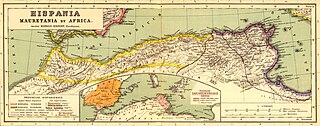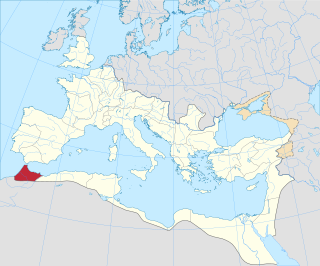Related Research Articles

Mauretania is the Latin name for a region in the ancient Maghreb. It stretched from central present-day Algeria westwards to the Atlantic, covering northern present-day Morocco, and southward to the Atlas Mountains. Its native inhabitants, of Berber ancestry, were known to the Romans as the Mauri and the Masaesyli.
Lucius Alfenus Senecio was a Roman figure of the late 2nd and early 3rd centuries.

Mauretania Tingitana was a Roman province, coinciding roughly with the northern part of present-day Morocco. The territory stretched from the northern peninsula opposite Gibraltar, to Sala Colonia and Volubilis to the south, and as far east as the Mulucha river. Its capital city was Tingis, which is the modern Tangier. Other major cities of the province were Iulia Valentia Banasa, Septem, Rusadir, Lixus and Tamuda.
Faltonius Restitutianus was a vir egrerius or eques who held several senior-level posts in the Roman Empire of the third century.
The gens Sertoria was a minor plebeian family at ancient Rome. Few members of this gens appear in history, the most illustrious of whom was the Roman general Quintus Sertorius, who defied the dictator Sulla and his allies for a decade after the populares were driven from power in Rome.

Cohors prima Flavia Canathenorum [sagittaria] [milliaria] was a Roman auxiliary cohort of infantry.

Quintus Julius Cordinus Gaius Rutilius Gallicus was a Roman senator who held several posts in the emperor's service. He was twice suffect consul: for the first time in the nundinium of September to October 70 AD; and the second time in 85 with Lucius Valerius Catullus Messalinus as his colleague, succeeding the Emperor Domitian.
The gens Sallustia, occasionally written Salustia, was a plebeian family at ancient Rome. Members of this gens are first mentioned in the time of Cicero, and from that time they attained particular distinction as statesmen and writers. The most illustrious of the family was the historian Gaius Sallustius Crispus, who wrote valuable works on the Jugurthine War and the Conspiracy of Catiline, which still exist.

The gens Sentia was a plebeian family at ancient Rome. Members of this gens are first mentioned in history toward the end of the Republic. The first of the Sentii to obtain the consulship was Gaius Sentius Saturninus, in 19 BC.
Marcus Gavius Maximus was an eques of ancient Rome who held several imperial positions, both civil and military, under Hadrian and Antoninus Pius.
Quintus Baienus Blassianus was a Roman eques who held a number of military and civilian positions during the reign of the Emperors Antoninus Pius and Marcus Aurelius, including praefectus of the Classis Britannica, and of Roman Egypt.
Quintus Caecilius Redditus was a Roman eques who held a number of appointments during the reigns of the Emperors Trajan and Hadrian. He is known in a series of inscriptions.
Publius Aelius Crispinus was a Roman eques who held a number of appointments in the second century AD. He is known from a series of inscriptions.
Decimus Veturius Macrinus was a Roman eques who is known to have held imperial appointments under both emperors Commodus and Septimius Severus. He is best known for being governor of Roman Egypt under Commodus and praetorian prefect under Severus.
Sextus Sentius Caecilianus was a Roman senator, who was active during the first century AD. He was suffect consul in an undetermined nundinium during the reign of Vespasian. He is known entirely from inscriptions.

Publius Besius Betuinianus Gaius Marius Memmius Sabinus was a Roman eques who held a number of military and civilian positions during the reign of the Emperor Trajan, and was twice decorated for his actions in battle. He is only known from inscriptions.
John Edward Houghton Spaul (1926–2018), sometimes known professionally as J. E. H. Spaul, was a British ancient historian and epigrapher. Much of his work focused on the Army of the Roman Empire.
References
- ↑ J.E.H. Spaul, "Governors of Tingitana", Antiquités africaines 30 (1994), p. 236
- ↑ Tacitus, Historiae, II, 58.
- ↑ IAM2, 126; CIL IX, 4194.
- ↑ CIL XVI, 56 = ILS 2003.
- ↑ AE 1985, 984.
- ↑ AE 2002, 1753 = RMD 5-377
- ↑ AE 1985, 991.
- ↑ CIL VIII, 8813, CIL VIII, 8814; CIL VIII, 21663 = ILS 5963; AE 1976, 738.
- ↑ AE 1911, 123, AE 1980, 970, & AE 1983, 789.
- ↑ CIL XVI, 199
- ↑ RGZM 32, AE 2002, 1732, AE 2011, 1808, & AE 2016, 1347 = RMD 5-405.
- ↑ CIL VIII, 20834, & CIL VIII, 21007
- ↑ CIL VIII, 9363 = ILS 1351, CIL VIII, 9364, & CIL X, 3849
- ↑ AE 1942/43, 69.
- ↑ AE 1929, 134; CIL VIII, 20816 = ILS 396.
- ↑ CIL VIII, 10351, CIL VIII, 10361, CIL VIII, 10364.
- ↑ CIL VIII, 9046, & AE 1911, 112.
- ↑ Spaul, "Governors of Tingitana", p. 248
- ↑ Spaul, "Governors of Tingitana", pp. 248f
- ↑ CIL VIII, 9049, CIL VIII, 9370, CIL VIII, 20845, CIL VIII, 20997, & AE 1937, 156.
- ↑ Spaul, "Governors of Tingitana", pp. 247f
- ↑ CIL VIII, 7001, CIL VIII, 22616, CIL VIII, 22617, & CIL VIII, 22618.
- ↑ AE 1929, 136.
- ↑ AE 2019, 1955.
- ↑ Zheira Kasdi, Souad Slimani, "Un nouveau gouverneur de la province de Maurétanie césarienne", Zeitschrift für Papyrologie und Epigraphik, Vol. 212 (2019), pp. 280–286
- ↑ CIL VIII, 22626, CIL VIII, 22628, AE 1967, 652 in the reign of Macrinus; CIL VIII, 10461, CIL VIII, 10462 in the reign of Elagabalus; CIL VIII, 10432, CIL VIII, 10468, & AE 1967, 654, in the reign of Alexander Severus.
- ↑ AE 1985, 976
- ↑ AE 1904, 151, CIL VIII, 20991, & CIL VIII, 20992.
- ↑ CIL VIII, 9790.
- ↑ CIL VIII, 9367, CIL VIII, 20996, AE 1966, 593, AE 1966, 596, AE 1966, 597.
- ↑ AE 1937, 46, AE 1938, 50; CIL VIII, 10470.
- ↑ CIL VIII, 8828 = ILS 6889, CIL VIII, 10438, & CIL VIII, 22619.
- ↑ AE 1957, 278.
- ↑ CIL VIII, 22624.
- ↑ AE 1903, 94, CIL VIII, 20487.
- ↑ CIL VIII, 21557 in the reign of Gordian III; CIL VIII, 22621 in the reign of Philip the Arab.
- ↑ AE 1908, 30, & CIL VIII, 8809 = ILS 5785.
- ↑ CIL VIII, 21000.
- ↑ AE 1956, 128, & AE 2001, 2137.
- ↑ AE 1902, 13, AE 1969/70, 727.
- ↑ AE 1930, 47.
- ↑ CIL VIII, 9002, & CIL VIII, 21662.
- ↑ AE 1958, 156.
- ↑ CIL VIII, 9288, CIL VIII, 20993, & AE 1980, 969.
